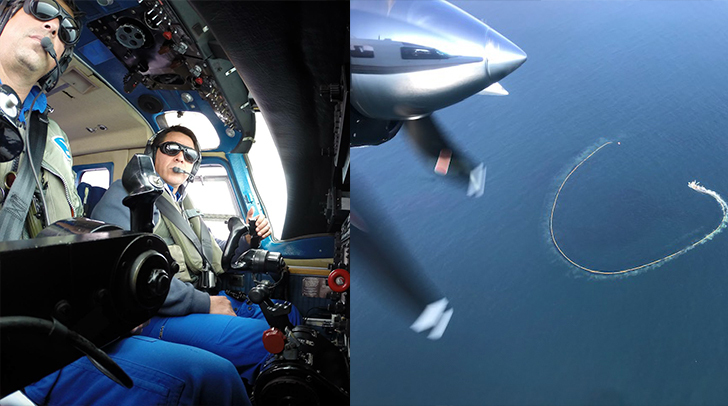
If you take a fish oil supplement or love the authenticity of some anchovy in your Caesar salad dressing, chances are you’ve supported a Twin Commander.

The coastal waters off northern Chile are some of the world’s most abundant fishing grounds. A top ten fish exporter, Chile is only slightly behind the United States in terms of total production, despite significantly less coastline. It’s a world leader in many areas, including anchovy, jack mackerel, and mackerel fishing. With fishing being such a major part of the economy, it’s not surprising that aviation plays a role.
During the country’s nine-month fishing season, on any given day you’ll find Fredy Castillo or one of his pilots flying a Twin Commander 500S for Camanchaca, exporter to 50 countries of everything from salmon to mackerel. Their job is to spot fish and direct the boat captains to the area, day or night. The flying, which they call fish prospecting, is a dance between pilot and boat captain with the goal of making a great catch.

“Specifically, the mission is to search for fish biomass throughout our territorial sea, report the positions to the ships, and direct the fishing maneuvers,” Castillo said. The flying is entirely visual, and can happen close to shore, or up to 200 miles offshore. Typically, they’ll fly between 1,000 and 3,000 feet, and limit flights to no more than six hours.
The pilots use a satellite service to provide them with sea conditions that they can then use to estimate where they’ll find the biggest concentration of fish. In daytime spotting the pilots can find the fish by looking for light brown areas in the water. Over time they’ve come to be able to even tell what species the group is based on color and movement. The pilot then coordinates the position with the boats and gives them specific directions as they encircle the fish.
If they’ve done this well the net can haul up 300 tons of fish each time. The company’s fleet at its base in Iquique has a yearly quota of 150,000 tons, so the work is tireless and can be intense, especially at night.
Anyone who has flown over an ocean at night knows how sky and sea can blend, making it difficult to fly reliably on visual cues alone. But Castillo and his fellow pilots need to be able to see the ocean, so they turn off all cockpit lights except for their primary flight displays, which they dim to the lowest levels. Castillo said that at night the fish take on an appearance similar to cigarette ashes. “When we fly over the school of fish, we throw a short beam of light from a spotlight that is in the belly of the aircraft below the pilot’s position, operated by a switch on the pilot’s controls. Then when the light falls on the school of fish, they react by moving faster. This causes an incandescence in the sea and the school of fish is momentarily shown in a more intense white color (fluorescent). By the intensity of the color and the shape of the school, we can distinguish the species.”

Obviously, this sort of flying takes some experience. Castillo has been with Camanchaca for 23 years, and has flown 15,000 hours in the fishery prospecting business. He manages a team of one technical advisor, two maintenance supervisors, two line mechanics, an electrical specialist, an airframe specialist, and three pilots. Each pilot is limited by the Chilean DGAC to 36 hours per week, 100 hours per month, 270 hours per quarter, and 1,000 hours a year. He said 850 hours a year is pretty typical. At night, two pilots are needed, although Camanchaca tries to have two pilots on every flight.

Aside from poor weather, they also avoid flying during full moon cycles – it’s actually too bright. Castillo said the light reflects off the water, obscuring the fish. Plus, they go deeper during fuller moons, and can’t be spotted from the air.
For an operation dependent only on visual flying, the airplane is very well equipped. An upgrade at Twin Commander Factory Authorized Service Center Naples Jet Center in 2019 included a new wing spar, a major avionics upgrade, and an STC that eliminated the auxiliary fuel selector and enabled continuous flow from all the tanks. The panel includes dual PFDs, dual Garmin GNS430s, a Garmin multifunction display, JP Instruments engine analyzer, Garmin G5, and more.

So, the next time you’re having a filet of salmon from Chile or taking your fish oil supplement, remember that it just may have been a Twin Commander that helped make it possible.
